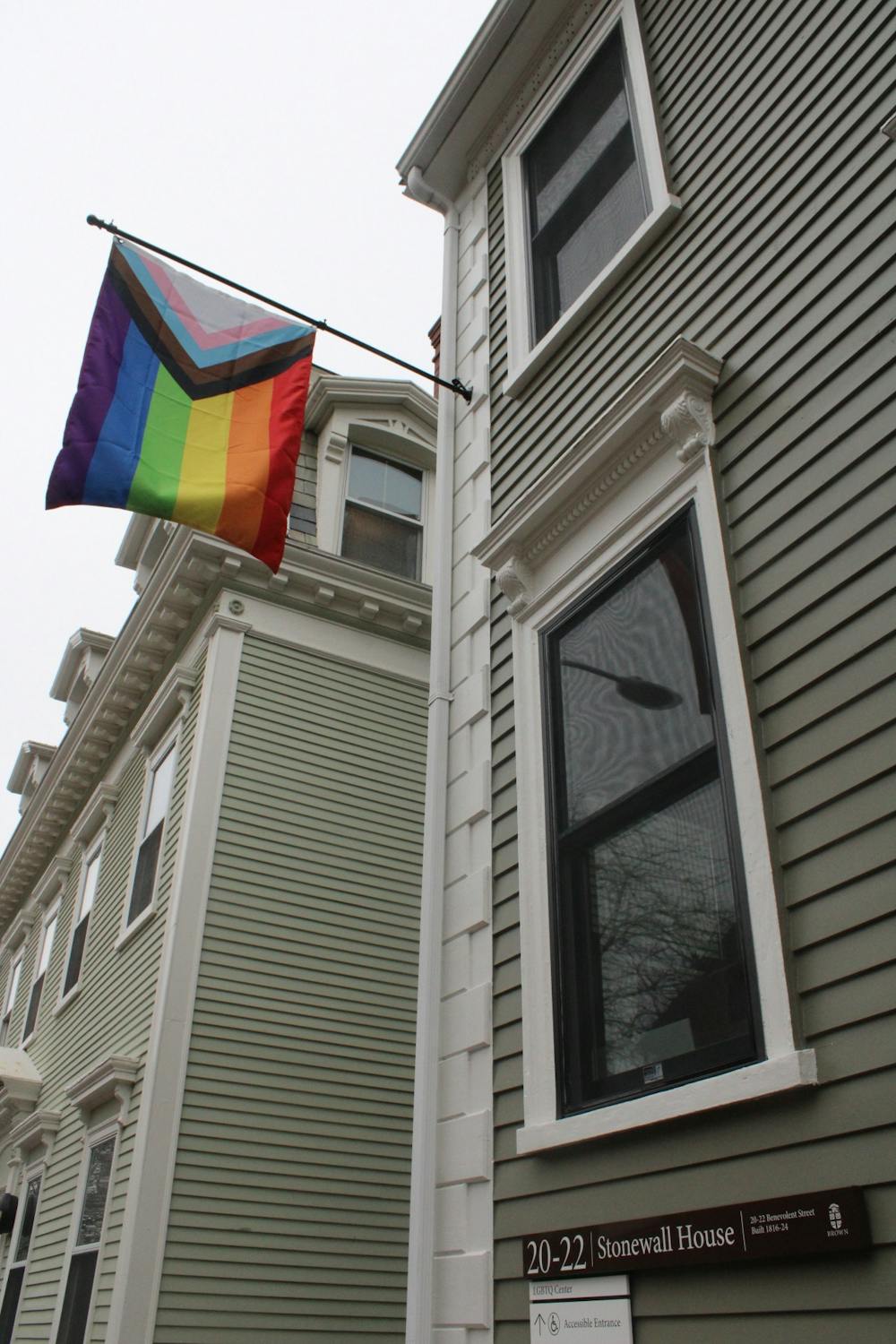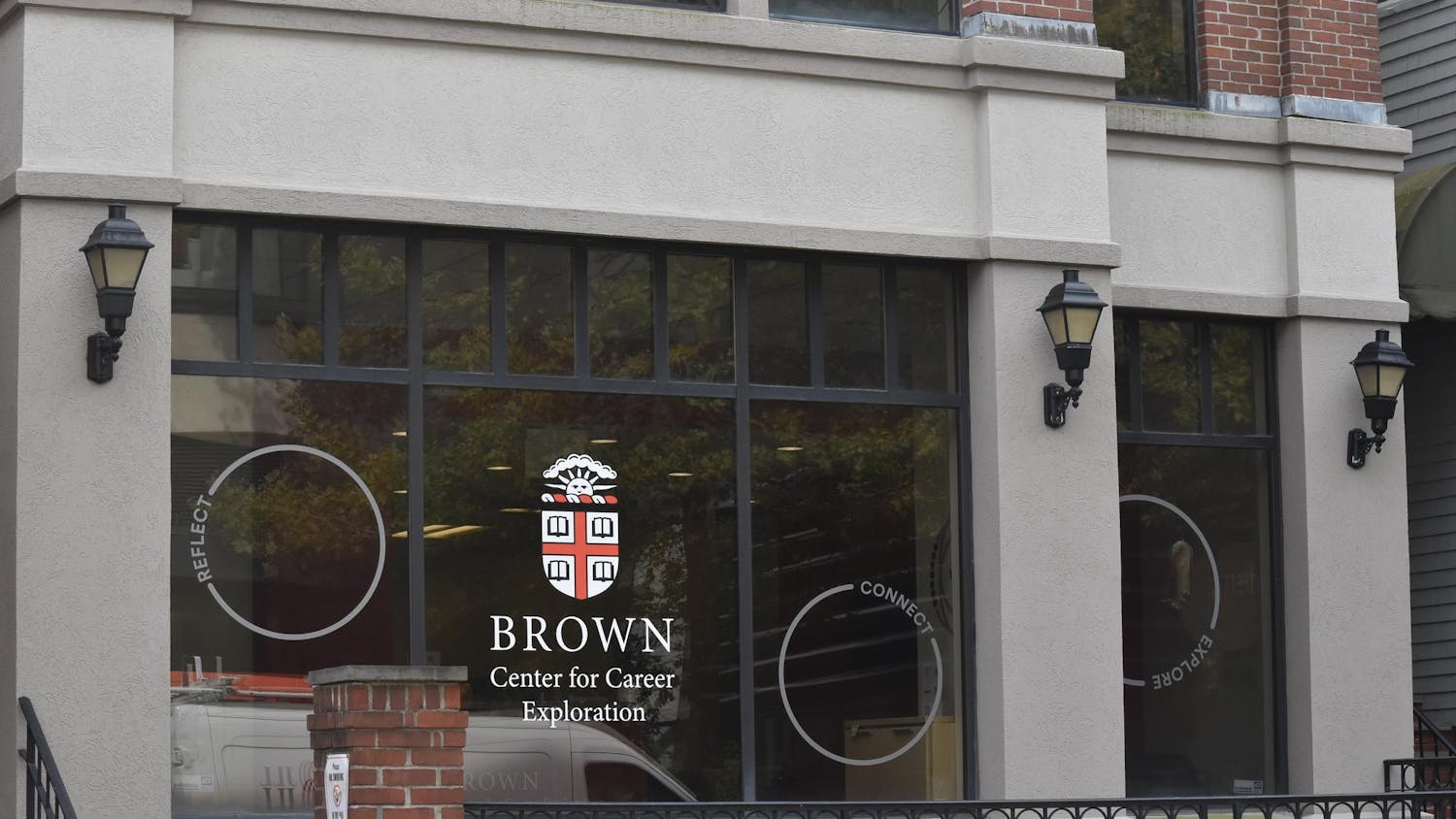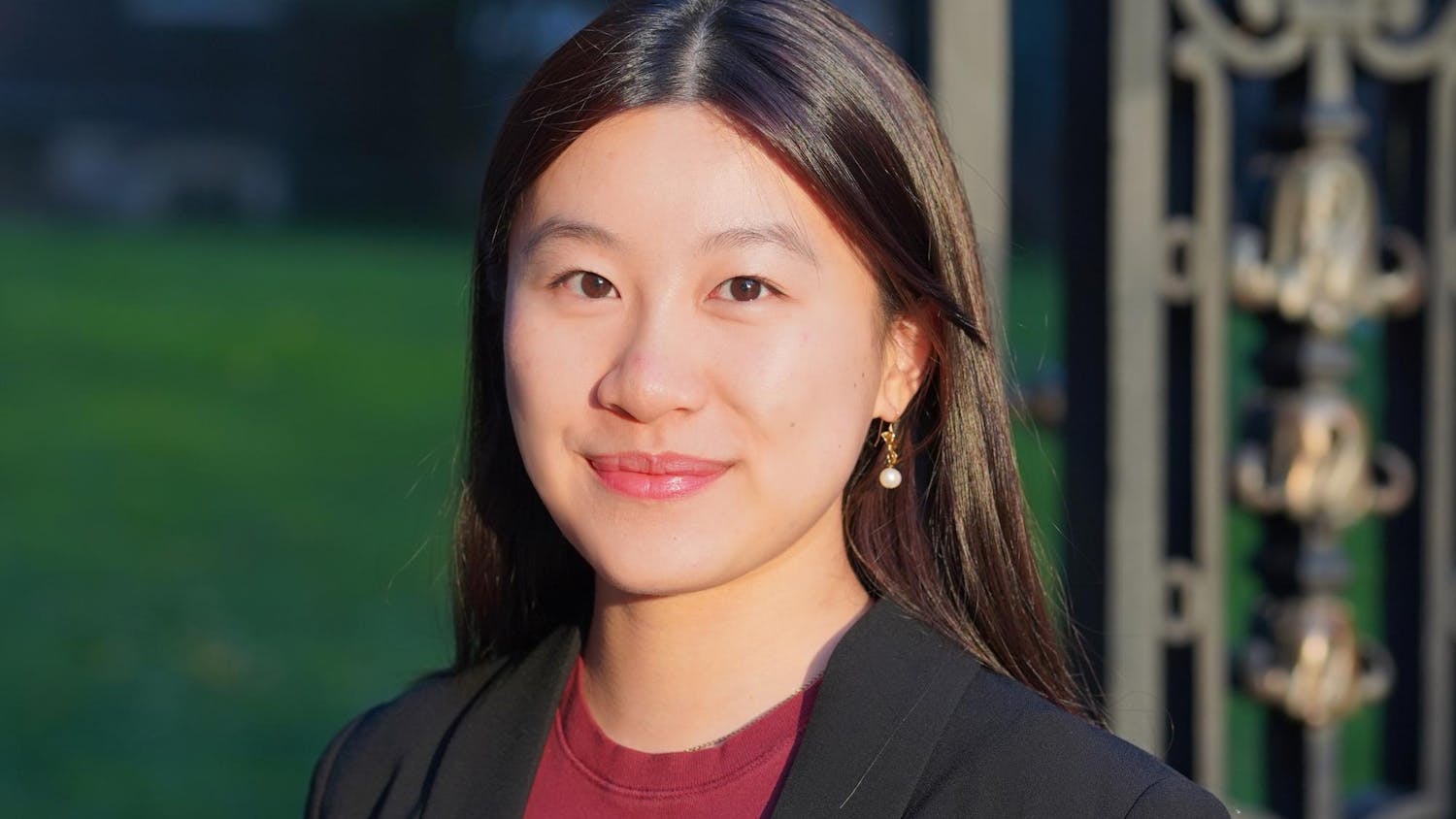Brown’s reputation is undeniably queer, Lainey Bechta ’25 said. “Part of what drew me to Brown is that it’s a historically more queer Ivy,” she said. “But now that I think about it, I don’t know where I heard that.”
Bechta’s understanding of the perception of Brown as a particularly — even predominantly — queer institution is widespread, but its roots are difficult to identify, Davi Sapiro-Gheiler ’23 said. “I think we’re known as a queer place,” they said. “It’s hard to say why that is.”
Over 35% of Brown’s current student body does not identify as heterosexual, according to a poll conducted by The Herald and the Brown Opinion Project in October. According to previous reporting by The Herald, queer studies are taught in several departments, the LGBTQ Center has moved into a larger renovated space and students flock to gay clubs. Students mentioned that queer culture and experience at Brown is fostered and regulated on many levels: by the actions of the administration, the norms of social communities and the reputation of the University as a whole.
“I feel like one of the reasons Brown attracts more queer people isn’t because of what the institution does, but because it has the reputation of being more liberal,” Chris Bianco ’25 said. “Obviously being politically liberal doesn’t necessarily go hand-in-hand with being queer, or being accepting of queerness, but there is correlation there. You kind of assume that since it’s a more liberal school, there’ll be more queer people and then more queer people will go.”
Though Brown is known as a queer place — and demographics of queerness are about five times the national average — queer people remain a minority on campus. “I would say there are niches and circles that feel intentionally and particularly queer,” Edie Fine ’25 said. “I was expecting more universal queerness, which I think is not the case.”
Coming from Los Angeles, Coco Kaleel ’24 expected more openly queer people than she first encountered. “When I showed up here, I thought everyone would be gay, but only some people were.” She acknowledges that her experience is unique in this regard — “I have talked to lots and lots of people who are like ‘are you kidding me, it’s so gay here,’ I’m like ‘what?’ and they’re like ‘nobody was gay where I’m from.’”
Fine, who was part of a predominantly queer community in New York City in high school, feels that “relatively, it’s not the queerest haven in the world. That’s a very particular history that I come from, that I know informs the way I interact with queerness,” they said. “I did start to see it as a default or as a norm, which is not the reality of most places.”
Though Brown is not consistently queer, Fine has found “havens within academic spaces, extracurriculars and off-campus clubs, that have felt super queer and really homey to me.”
Strides made by the administration at Brown — which is openly and vocally supportive of queer students — contribute to queer safety and culture on campus, Director of the LGBTQ Center Caitlin O’Neill said. “We’re really seeing a clear investment in the experience of LGBTQ students at Brown: from Brown higher administration, from Brown alumni and from Brown parents,” they said. “And I think Stonewall House is a really great symbol of that. To make more space for LGBTQ students, being able to expand the budget, marking that as somewhat of a priority around fundraising … acknowledging that that’s really cool, and that speaks to changing tides.”
In the past, the center has worked with the administration to adopt policies that support queer students, such as making name and email changes self-service and having multiple pronoun options on Banner, O’Neill said.
In recent years, due to changes in the political and social atmosphere at Brown and around the nation, the work of the center has begun to look different, she said. While the center used to be one of the only safe spaces for queer people on campus, “there are (now) lots of places where students and faculty can feel whole and seen in their identities, which allows us to think more about, for instance, how we’re connected to the academic mission of the university, how we create spaces of belonging,” they said.
Currently, the center is working on “bringing more artists, scholars, performers, intellectual individuals to share their work and to talk about how it intersects with LGBTQ identity,” O’Neill said. Student staff members are also doing digital outreach, archiving queer history and helping to expand the closet at the center, which is designed in part to “provide gender-affirming garments and underwear to students who need it,” they added.
The administration’s support of the center is vital to its existence, O’Neill said. “It’s important to note that I’m a university administrator, so yes — the center is absolutely part of Brown, part of the overarching administrative structure.”
The support of queer students by the administration is the result of a complicated history, the Herald previously reported.
Several clubs on campus use the center as a space for their programming, O’Neill said. The Next Thing, a confidential support group for queer students of color, has in past semesters used the space to hold meetings. The group “acknowledges the ways in which historically people of color have struggled with being seen and included in the LGBTQ movement,” they said. “So this is Brown students’ way of being like ‘okay, what is the kind of space we’d like to see for ourselves and build for ourselves?’”
The Queer Alliance, which “serves as a hub of queer organizing on campus, with a mission to foster and facilitate queer leadership and programming,” according to the Brown website, also meets at the center.
In the past, the QA has organized LGBTQ dinners, queer carnivals and PrideProm, an event for queer students to have a prom uncentered around heteronormativity, as the Herald previously reported.
The institutional support of queerness at Brown goes beyond the Center; queer studies — history, theory and culture, in particular — are taught in several departments at Brown.
“Academically, I seek out courses where queerness is a big part of the syllabus,” Fine said. Their first semester at Brown, Fine took a trans-lit class that allowed them “to learn in an affinity space. There were vastly different experiences in the container of the class, but we had some shared understanding of moving through the world in a rejection of normativity.”
But some classes that are not academically focused on queer experience can also become queer spaces. Humanities classes tend to be more associated with queerness, according to Bechta, who is planning to double concentrate in Literary Arts and Architecture. Their classes — particularly those focused on creative writing — have a large population of queer people.
Bianco, on the other hand, has noticed that the classes he is taking for his mechanical engineering degree tend to be predominantly straight, he said.
“In my perspective, a large part of queer experience is having been through a process of dealing with who you are and how that’s different from societal expectations, and being okay with that — and part of that is getting in touch with your emotions, and frequently, consuming lots and lots of media, like literature and film,” Kaleel said. “With that, I wouldn’t be surprised if there’s a higher population trend towards trying to understand why that media could be so impactful, or how media can be impactful generally.”
Kaleel is double concentrating in Computer Science and Music, and they have noticed that while some institutional spaces they are part of — such as Environmental Program Housing and Brown Design Workshop — are not explicitly queer, they are predominantly queer.
Similarly, Fine feels that the Underground Coffee Company, the student-run café at which they work, is very queer. “There are spaces that are not intentionally or explicitly queer that sort of become that way because of the nature of what they are,” they said.
Though Bechta has never attended programming by the Center or other queer-related and administration-sanctioned events, she often finds herself in wholly queer settings, she said. “I stop by when I see (a LGBTQ Center) table, and I get a pin — and I see those pins all over the place, the bears with the rainbow outline,” she said. “And I’m like, ‘oh cool, another one.’”
The sightings of these pins — which are sponsored by the administration, but worn by queer individuals who are not necessarily affiliated with one specific campus organization — are representative of a broader trend at Brown: queer spaces are not exclusively institutional.
Luci Jones ’23 has “never been the kind of person who joined GSA in high school,” she said. “I think I've gone to Pride maybe twice and it was great, but I kind of was like, ‘my legs are tired.’ ”
When she first got to Brown, Jones was excited by the idea of institutionally organized queer spaces, such as the LGBTQ Center. But after attending a workshop about bisexuality at the Center during her freshman year, she realized that spaces designed to discuss queerness weren’t what she was looking for. “I obviously wanted to find other queer people, but just being in spaces where all we were talking about was our queer identity didn’t totally work for me,” she said.
At the beginning of this year, Jones began running Queer Soccer, an informal space for queer students to find community while playing a low-pressure sport, The Herald previously reported.
Kaleel attended Queer Soccer this semester and enjoyed the social experience. “I was curious to see if it would feel like ‘oh my God, this space is specifically queer,’ but it kind of just felt like another group of people at Brown,” she said.
Other clubs on campus, though not explicitly queer in their origins, have become spaces of queer joy and community, such as the Poler Bears, Brown’s pole dancing club. It was one of the reasons Fine chose to come to Brown — they “started to learn about what (the Poler Bears) did before even getting into Brown, because of the culture, the celebration and liberation of a space that is inherently sex positive and performance-oriented. It made me really excited to be on a campus that had that as a possibility, that that could even possibly emerge from the culture that existed here.”
When Fine auditioned for the Poler Bears, the directors at the time were beginning to alter the originally skill-oriented makeup of the team to “rewrite the narrative of the script of what the club had previously been,” they said. Though Fine had no prior experience in pole dancing, they had a background in drag and queer performance art, which appealed to the directors. “From there, it became much more of a space of queer expression.”
Now that Fine is co-directing the club, they are able to help construct the team by auditioning new people, and they “continued on that path by being intentional about the folks we allow onto the team. It’s really about the community of it as much as it is about the skill.”
Fine is also in the process of beginning Brown’s first burlesque club, in which they intend to create a similar atmosphere of queer performace.
Outside of purposefully queer spaces campus organizations, queerness exists in social communities within the greater Brown community as well.
For Jones, “queer community has come in the form of mostly queer friendship,” she said. “I think just having that sense of shared experiences, it's the most comforting and most validating space for me. I wouldn’t say I actively seek out LGBTQ spaces on campus, I just gravitate towards people who are understanding of my experience, and those often happen to be people who are also queer.”
“I came into this school identifying as a gay man and I’m leaving as a trans woman,” Sapiro-Gheiler said. “This is a place where I was able to explore a lot more of living in the ways I want to, the ways that make me happy and joyful — whether that’s from being outside of the home environment, being in the Brown environment, the people I’ve met here, it’s a combination of everything — but I’ve definitely been able to feel more comfortable being queer here than anywhere else.”
Heteronormativity is subverted at Brown, Bianco said, because straightness is rarely assumed. “People are more fashionably adventurous here, so you can’t assume (any sexual orientation),” Bechta said. “That was a thing first semester, I was like ‘wow, there are so many gay people,’ and then I realized sometimes straight people just had counterculture fashion.”
Brown is also a relatively comfortable place to come out informally, Kaleel said. “People (have stopped) really coming out, they’re just talking about crushes or making out with people at parties.”
Unlike at Bianco’s high school, they “haven’t noticed any real divide” between queer and straight communities. “The fact that I’m queer has had way less of a bearing on my social groups than it did in high school, it’s not even something I really consider. Things just happen how they happen and that’s what it is.”
Bechta’s friend group contains a mix of queer and straight people — “I’m definitely hanging out with way more cishet people than I was in high school,” they said — though she has a separate group of friends that are exclusively and explicitly queer. They sometimes find themselves wanting to spend time with those people for the experience of being surrounded by queerness, she said.
Both queer and straight people socialize at EGO, a gay club in downtown Providence, Kaleel said. It was a popular space during her first year, since the club is 18+ and cheaper than usual on Thursday nights.
Though straight people go to EGO to party, the atmosphere is still predominantly queer, Kaleel said. “I’ve been at EGO and been like ‘okay, straight friends, you have to tip the queens. Let’s talk through how this is gonna happen.’”
Being a first-year student when COVID-19 regulations were in place changed Kaleel’s relationship to queer communities at Brown, she said. The people who lived directly next to her — and the only ones she had social access to, because no clubs or classes were held in person — were overwhelmingly straight. “Certainly when we met they were like ‘you are the first gay person I’ve ever been friends with.’ I definitely felt forced into a representative role… I was like ‘this is weird and isolating.’ ”
“That’s informing my experience a lot when I say (Brown is) less queer than people think,” Kaleel said.
Now, Kaleel has found her place in a more queer social environment — many of her friends from first year have come out, and she has joined environments that are significantly more queer. “Right now, I would say Brown is pretty queer. That feeling has evolved, though, since I was a (first-year), when I did not feel (that) way … the social scene I exist within is very queer. A party I was at last night — I’m trying to think if I know a single straight person in that room.”
Liliana Greyf is a senior staff writer covering College Hill, Fox Point and the Jewelry District, and Brown's relationship with Providence. She is a sophomore studying Literary Arts and a proponent of most pickled vegetables.





